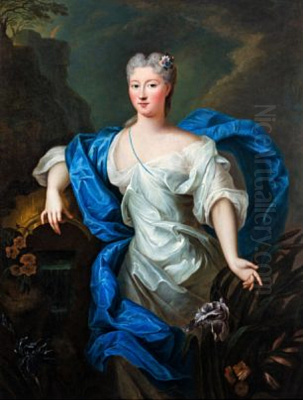
Pierre Gobert stands as a significant figure in the landscape of French art during the late seventeenth and early eighteenth centuries. Active during a period of stylistic transition, Gobert carved a niche for himself as a favoured portraitist of the French royal family and aristocracy, capturing the likenesses of key figures during the final years of Louis XIV's reign, the subsequent Régence, and the early years of Louis XV. His work offers a fascinating window into the world of courtly life, blending the formal grandeur inherited from the Grand Siècle with the emerging grace and intimacy of the Rococo.
Early Life and Artistic Formation in Fontainebleau
Pierre Gobert was born in Fontainebleau in 1662. This location was significant; Fontainebleau was not just a royal residence but a place steeped in artistic history, having been a major centre for French Renaissance art under Francis I, featuring works by Italian masters like Rosso Fiorentino and Francesco Primaticcio. Gobert's familial background was firmly rooted in the arts. His father, Jean Gobert, was a sculptor, as was his uncle, André Gobert. Growing up in such an environment undoubtedly exposed the young Pierre to artistic practice and the world of royal patronage from an early age.
Details of his formal training are somewhat scarce, a common issue for artists of this period unless they left detailed records or were subjects of early biographies. However, it is clear he demonstrated considerable talent early on. By 1682, at the young age of twenty, he was already working for the court, specifically the Bâtiments du Roi (the Royal Buildings administration, which oversaw artistic commissions). This early entry into court service suggests either remarkable precocity or influential connections, possibly through his family's existing artistic ties. His initial work likely involved contributing to the vast decorative schemes or perhaps undertaking minor portrait commissions.
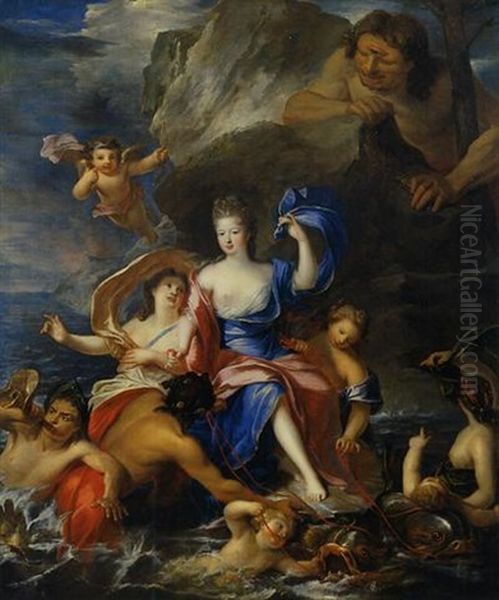
Fontainebleau itself, while perhaps less central than Versailles during Louis XIV's later reign, remained an important royal site. Gobert's upbringing there placed him geographically and culturally close to the orbit of royal power and artistic activity, providing a foundation for his future career centred on capturing the images of France's elite. His father's and uncle's profession as sculptors might also have subtly influenced his approach to form and likeness in his portraiture.
Acceptance into the Académie Royale and Early Court Success
A pivotal moment in any ambitious French artist's career during this era was acceptance into the Académie Royale de Peinture et de Sculpture (Royal Academy of Painting and Sculpture). Founded in 1648 under the patronage of Louis XIV, the Académie was the dominant institution governing the arts in France. Membership conferred prestige, access to royal commissions, and the right to exhibit at the official Salons. Gobert was formally received (reçu) as a full member of the Académie on September 24, 1701. His reception pieces were portraits of the painter Corneille de Lyon and the sculptor Jean-Baptiste Tuby, demonstrating his skill in the required genre.
Even before his official reception into the Academy, Gobert was building a reputation. His service to the court began in 1682, indicating nearly two decades of work within the royal sphere before achieving full academic recognition. During the late reign of Louis XIV, the dominant figures in portraiture were arguably Hyacinthe Rigaud, master of the grand state portrait, and Nicolas de Largillière, known for his rich textures and portraits of both aristocracy and the wealthy bourgeoisie. Pierre Mignard had also been a major figure, rivaling the Academy's first director Charles Le Brun, until his death in 1695.
Gobert found his particular strength in portraying the female members of the court and children. While Rigaud excelled at conveying the power and majesty of figures like Louis XIV himself, Gobert developed a softer, more graceful style that proved highly appealing for capturing the elegance and charm of princesses and duchesses. His ability to flatter his sitters while retaining a recognizable likeness was a key factor in his success. He became particularly favoured by the ladies of Versailles, who appreciated his delicate rendering of features, complexions, and luxurious fabrics.
Portraitist of Princes and Princesses: The Height of Gobert's Career
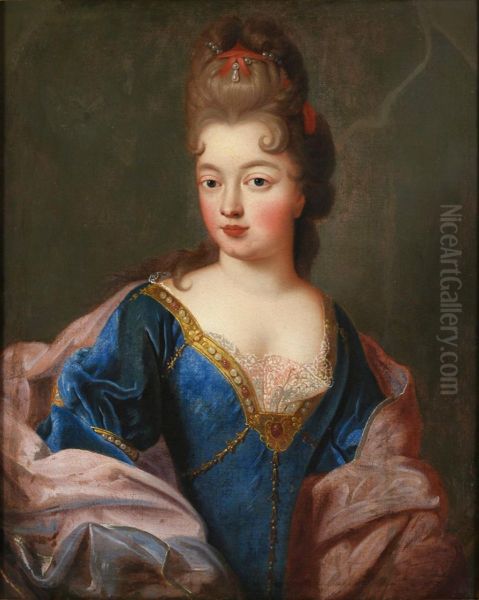
The period spanning the last decade of Louis XIV's reign, the Régence of Philippe II, Duke of Orléans (1715-1723), and the early majority of Louis XV marked the zenith of Pierre Gobert's career. He became one of the most sought-after portraitists for the extended royal family and high nobility. His status was solidified, and he received numerous prestigious commissions.
Between September 1707 and March 1709, Gobert travelled to the court of Lorraine in Lunéville. There, he painted portraits of Duke Léopold of Lorraine and his family. This commission outside the immediate French court demonstrates his growing reputation across Europe. The court of Lorraine had close ties to the French royal family, and patronage often flowed between these interconnected aristocratic circles.
Gobert was especially prolific in painting the numerous children and grandchildren of Louis XIV. He painted portraits of the Duke of Burgundy (Louis XV's father), various princesses of the blood, and members of the powerful Orléans family. His skill in capturing the innocence and burgeoning status of royal children was particularly valued. These portraits served not only as personal mementos but also as dynastic statements, circulated among European courts.
One of his most famous subjects was the young Louis XV. Gobert painted him multiple times during his childhood. A notable example depicts the king around the age of ten, likely painted circa 1720. These portraits show the young monarch often clad in formal attire, embodying his royal status even at a tender age, yet Gobert manages to retain a sense of youthful sensitivity. These works stand in contrast to the more imposing, adult state portraits later executed by artists like Carle Van Loo or Maurice Quentin de La Tour.
He also painted portraits of Marie Leszczyńska, the Polish princess who would become Queen of France through her marriage to Louis XV in 1725. Capturing the likeness of a future queen was a significant commission, further cementing Gobert's position within the court's artistic hierarchy. His ability to navigate the complex social and political environment of the court was as crucial as his artistic talent.
Artistic Style: Bridging Baroque Grandeur and Rococo Grace
Pierre Gobert's artistic style is often characterized as a bridge between the formal, imposing Baroque style associated with the reign of Louis XIV and the lighter, more intimate Rococo style that flourished under Louis XV. His work retains elements of the grandeur and dignity expected of court portraiture but infuses it with a new softness, elegance, and charm.
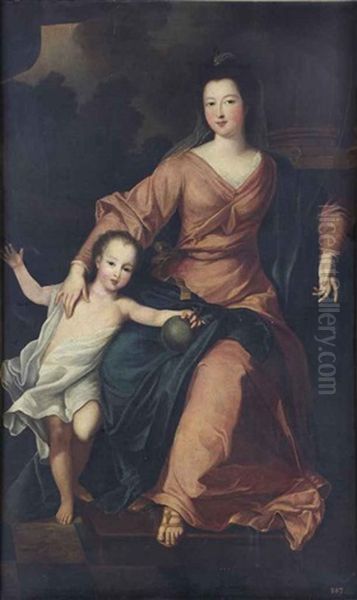
The influence of the Louis XIV era, dominated by the artistic direction of Charles Le Brun and the portraiture of Rigaud and Mignard, is visible in Gobert's attention to rich fabrics, intricate lace, and symbolic accessories that denote the sitter's rank and status. Poses can still be formal, referencing classical sculpture or established conventions of aristocratic representation, recalling the influence of masters like Anthony van Dyck whose courtly style had a profound impact across Europe.
However, Gobert's handling of paint is often smoother and more delicate than that of Rigaud. He excelled at rendering luminous skin tones, particularly for his female sitters, and capturing the textures of silk, velvet, and jewels with a refined touch. His colour palette tends to be rich but often incorporates softer pastel shades that anticipate the Rococo aesthetic championed later by artists like François Boucher and Jean-Marc Nattier.
Gobert frequently employed the convention of the portrait historié, or historiated portrait, where the sitter is depicted in the guise of a mythological or allegorical figure. This practice allowed for a degree of fantasy and flattery, elevating the subject beyond a mere likeness. His Portrait of Mademoiselle de Blois (Françoise Marie de Bourbon, daughter of Louis XIV and Madame de Montespan) as Galatea is a prime example, casting the princess as the beautiful sea nymph. This approach became particularly fashionable in the early to mid-18th century, with Nattier later becoming its most famous practitioner.
Compared to his contemporaries, Gobert's psychological depth might be considered less probing than Rigaud's portrayal of powerful men or Largillière's robust characterizations. Gobert's primary aim often seems to be elegance, grace, and an idealized, flattering likeness, particularly suited to the tastes of his aristocratic female clientele and the depiction of children.
Representative Works
Several key works exemplify Pierre Gobert's style and subject matter:
Portraits of the Young Louis XV: As mentioned, Gobert painted Louis XV on several occasions during his youth. The portrait of the king around age ten (circa 1720, versions exist in Versailles and elsewhere) is particularly well-known. It shows the young monarch in armour or court dress, holding a commander's baton, signifying his royal authority despite his age. Gobert captures a blend of boyishness and regal bearing.
Portrait of Louise Élisabeth d'Orléans, Queen of Spain: Gobert painted many members of the Orléans family. Louise Élisabeth (1709-1742), daughter of the Regent Philippe II, Duke of Orléans, briefly became Queen of Spain in 1724. Gobert's portraits of her capture the youthful elegance typical of his female subjects.
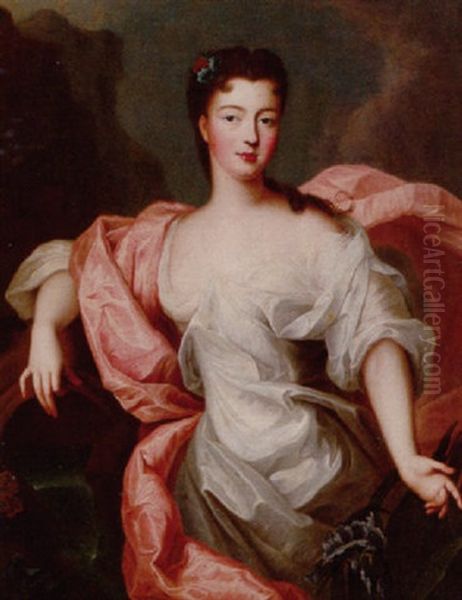
Portrait of Mademoiselle de Blois as Galatea (Triumph of Galatea): This work (versions exist, including one possibly at Versailles) is a clear example of the portrait historié. It depicts Françoise Marie de Bourbon, Légitimée de France, Duchess of Orléans, in a mythological guise, surrounded by attendants, embodying classical beauty and aristocratic status simultaneously.
The Rape of Europa (after Titian?): A painting titled The Rape of Europa by Jupiter transformed into a Bull, dated around 1700 and housed in the Victoria and Albert Museum, London, is attributed to Gobert. While mythological scenes were not his primary focus, this work shows his engagement with classical themes popular during the period. Its connection to Titian might suggest Gobert studied or copied works by the Venetian master, whose influence, particularly in colour and composition, permeated European painting. It's worth noting that copying Old Masters was a standard part of academic training.
Portraits of the Princesses de Rohan: Gobert painted several members of the influential Rohan family, important figures at court. These portraits, often featuring elaborate gowns and settings, further showcase his skill in depicting aristocratic luxury and refinement.
These works, among many others now housed in collections like the Musée National des Châteaux de Versailles et de Trianon, the Prado Museum in Madrid, the V&A in London, and various private collections, solidify Gobert's reputation as a chronicler of the French elite.
Workshop Practices, Attribution Challenges, and Legacy
Like most successful painters of his time, Pierre Gobert likely maintained a studio with assistants. This was standard practice for handling the volume of commissions, which often included requests for multiple versions or copies of successful portraits to be distributed among family members or sent to other courts. Assistants would help with preparatory work, painting drapery, backgrounds, or producing replicas under the master's supervision.
This studio practice contributes to one of the challenges in studying Gobert: attribution. Gobert himself rarely signed his paintings. While his style is often recognizable – particularly the smooth finish, delicate rendering of faces, and characteristic poses – the involvement of studio hands can complicate definitive attribution for some works. Distinguishing between a work entirely by Gobert, a work largely by him with studio assistance, or a contemporary studio copy requires careful connoisseurship and technical analysis.
Despite these challenges, Gobert's output was significant, and his influence, while perhaps not as transformative as that of Watteau or Boucher in the development of the Rococo, was felt within the specific genre of court portraiture. He provided a model for elegant, flattering depictions of royalty and nobility that balanced tradition with evolving tastes. His success demonstrated the continued importance of portraiture as a means of conveying status and forging dynastic connections.
His legacy lies primarily in the historical value of his works. They provide invaluable visual records of key figures during a crucial period of French history. His portraits document the fashions, ideals of beauty, and social hierarchies of the late Baroque and early Rococo court. While later artists like Jean-Marc Nattier would push the portrait historié further, and Maurice Quentin de La Tour would achieve startling psychological realism in pastel, Gobert remains a key figure who expertly navigated the demands of court patronage.
Gobert in the Broader Context of French Art
Placing Pierre Gobert within the wider context of French art during his lifetime highlights the richness and diversity of the period. While he specialized in aristocratic portraiture, other artists were exploring different genres and styles. Antoine Watteau, a contemporary, was pioneering the fête galante, depicting scenes of courtship and theatricality with a poetic melancholy that defined the early Rococo. Jean-Baptiste Oudry excelled in painting animals, hunts, and still lifes, also receiving significant royal patronage.
Later in Gobert's life, the Rococo style reached its full expression with François Boucher, whose mythological scenes and decorative paintings epitomized sensuousness and charm, and Jean-Honoré Fragonard, who captured intimate moments with unparalleled energy. In contrast to the courtly and mythological focus of many Académie painters, Jean Siméon Chardin offered quiet, intimate depictions of domestic life and remarkably textured still lifes, finding beauty in the everyday.
Gobert's career unfolded against this backdrop of stylistic evolution and diversification. He remained largely focused on the established tradition of court portraiture, adapting it subtly to changing tastes rather than radically innovating. His relationship with contemporaries like Rigaud and Largillière seems to have been one of professional coexistence rather than overt rivalry, each catering to slightly different aspects of the portrait market, although they undoubtedly competed for prestigious commissions. Gobert's particular success with female and child portraits gave him a distinct advantage in that domain.
His adherence to a certain formula, while ensuring consistency and satisfying patrons, perhaps limited his artistic range compared to some contemporaries. Yet, within his chosen specialty, he achieved a high level of refinement and left behind a substantial body of work that continues to be studied for its artistic qualities and historical significance.
Conclusion: An Elegant Chronicler of the Ancien Régime
Pierre Gobert died in Paris in 1744, having lived through and documented a period of significant change in France. From the late grandeur of Louis XIV's reign to the developing Rococo aesthetic under Louis XV, Gobert's portraits captured the faces of the French elite with elegance and refinement. As the son and nephew of sculptors, he brought a sensitivity to form and likeness to his work, establishing himself as a favoured painter at the courts of Versailles and Lunéville.
His membership in the Académie Royale and his numerous commissions from the royal family, including multiple portraits of the young Louis XV and the future Queen Marie Leszczyńska, attest to his success and status. While perhaps overshadowed in grand state portraiture by Hyacinthe Rigaud, Gobert excelled in capturing the grace of court ladies and the charm of royal children, often employing the fashionable device of the portrait historié.
His style, a blend of late Baroque formality and emerging Rococo lightness, perfectly suited the tastes of his aristocratic clientele. Although challenges in attribution exist due to his infrequent signing and common studio practices, his recognizable style ensures his place in art history. His works remain essential visual documents of the Ancien Régime, offering glimpses into the lives, fashions, and personalities of those who inhabited the rarefied world of the French court. Pierre Gobert endures as a skillful and elegant chronicler of his time.